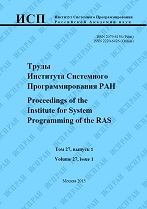|
Conversion of abstract behavioral scenarios into scenarios applicable for testing
P. D. Drobintsev, V. P. Kotlyarov, I. V. Nikiforov, N. V. Voinov, I. A. Selin
Peter the Great Saint-Petersburg Polytechnic University
Abstract:
In this article, an approach of detailing verified test scenarios for developed software system without losing the model's semantics is proposed. Existing problem of generating test cases for real software systems is solved by using multi-level paradigm to obtain the real system signals, transactions and states. Because of this, the process is divided into several steps. Initial abstract traces (test cases) with symbolic values are generated from the verified behavioral model of software product. On the next step, called concretization, these values in test scenarios are replaced with concrete ones. Resulting concrete traces are then used as input for the next step, data structures conversion. This step is needed because concrete traces do not contain all the information for communicating with developed software and presented in another way with different data structures. After concrete test scenarios are detailed, they can be used for generation of executable test cases for informational and control systems. In this paper, a software tool is suggested for detailing test scenarios. It consists of several modules: a Lowering editor that allows user to create rules of detailing a signal, a Signals editor used to define complex data structures inside the signal and a Templates editor that eases work with similar signals. Process of translating abstract data structures into detailed data structures used in system implementation is presented with examples.
Keywords:
model approach, model verification, test mapping.
Citation:
P. D. Drobintsev, V. P. Kotlyarov, I. V. Nikiforov, N. V. Voinov, I. A. Selin, “Conversion of abstract behavioral scenarios into scenarios applicable for testing”, Proceedings of ISP RAS, 28:3 (2016), 145–160
Linking options:
https://www.mathnet.ru/eng/tisp42 https://www.mathnet.ru/eng/tisp/v28/i3/p145
|

| Statistics & downloads: |
| Abstract page: | 132 | | Full-text PDF : | 66 | | References: | 38 |
|




 Contact us:
Contact us: Terms of Use
Terms of Use
 Registration to the website
Registration to the website Logotypes
Logotypes








 Citation in format
Citation in format 